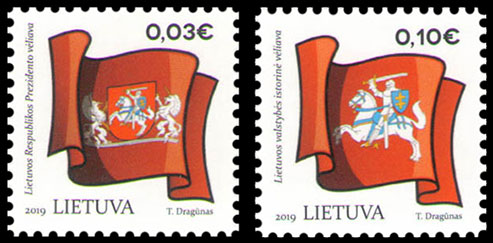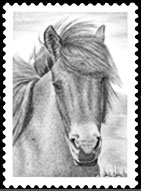
On January 4, 2019, Lithuanian Post issued a series of standard postage stamps entitled "Lithuanian National Symbols. Flags."
The coat of arms, flag, and anthem are the most important symbols of any state. Official state symbols reflect the country's history and values, and by them, states are easily recognized throughout the world. National symbols are perhaps one of the most common themes on postage stamps, from the classical period to the present day. This is not surprising, as postage stamps are one way of introducing a country to the world, introducing residents of other countries to its national history, culture, and important events.

The theme of the new issue of Lithuanian standard stamps is national flags. Lithuanian artist Tomas Dragunas depicts three flags on the stamps: the Presidential Flag of Lithuania, the historical national flag of Lithuania, and the modern national flag of Lithuania.
The first stamp in the series, with a denomination of €0.03, depicts the standard of the President of Lithuania. In the center of the purple flag is the national coat of arms of Lithuania, depicting Vytis, whose shield is held by a white griffin on the right side and a white unicorn on the left. The presidential flag was approved in 1993 and designed by Arvydas Kazhdailis.
Along with the national yellow, green, and red flag, Lithuania also officially uses the "historical national flag of Lithuania," which was approved by the Seimas of Lithuania in 2004. Its prototype is the banners of the regiments of the Grand Duchy of Lithuania at the Battle of Grunwald in 1410. The historical flag is a red cloth bearing the image of a Pahonia, a silver armored rider on a white horse, holding a sword raised above his head. The rider's left shoulder is covered by a blue shield with a double gold cross. This flag is depicted on the €0.10 stamp.
The stamps, printed on self-adhesive paper, were printed in Estonia in a print run of 600,000 copies. A first-day cover and a special postmark were developed for the stamp series. Cancellation took place on the first day of issue at the Vilnius post office.
Перейти в каталог
I apologize for any errors or inaccuracies


